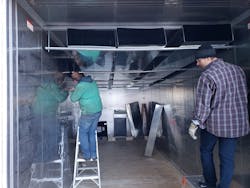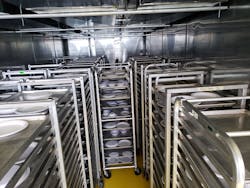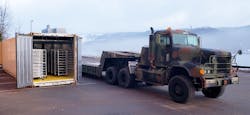Improvising fast solutions with ingenuity and at scale is becoming de rigueur as engineers step up efforts to help out during a time of critical need.
In this case, it took an engineering team at Michigan Technological University just two days to build a mobile thermal utility (MTU) sanitizer using off-the-shelf parts—a shipping container, 25 racks and a heating unit—and assemble experts to put a prototype together.
The engineers’ stated plan: “Disinfect protective equipment (PPE) at temperatures hot enough to break up coronaviruses and do so in a big, moveable oven that can be quickly made with local, off-the-shelf parts that are easy to get and put together.”
A refrigeration unit was swapped out of a thick-walled shipping container and replaced with a heating unit run on an electric generator. The unit, lined with stainless steel racks and trays for holding PPE, can heat up to 140-170°F, clean 5,000 to 10,000 PPE units every two hours and run continuously.
The parts are all available in commercial bakeries, restaurants, HVAC shops, shipping yards and universities, noted the engineers. The prototype was tested in a campus parking lot alongside local air conditioning contractor Aire Care before heading off for further validation testing.
The World Health Organization and U.S. Centers for Disease Control and Prevention (CDC) recommend heat-soaking to eliminate coronaviruses like the one that causes COVID-19. The CDC now offers guidelines on temperature ranges and time for effectiveness.
“Our goal is to make a massively available and scalable mobile sanitation unit for hospital PPE,” said Andrew Barnard, a mechanical engineer at Michigan Tech and the director of the Great Lakes Research Center. “We’ve seen DIY versions using food dehydrators and ovens. We’re making it bigger, but still transportable.”
PPE includes lab coats, gowns, N95 masks, face shields, sleeves and other protective garments that help prevent the spread of disease and keep healthcare workers and lab technicians safe. In addition to disinfecting large amounts of PPE—upwards of 60,000 PPE units or more each day—the MTU sanitizer can clean large items such as gurneys, beds, firefighter gear and other contaminated materials that are hard to clean using chemicals or smaller ovens.
The design and build were a true community (and family) effort: Andrew Barnard’s cousin, Dan Barnard is one of the inventors of the design. His wife, Amy, a biomedical engineer by training, also pitched in. Amy’s father, Brad Andreae, owner of an industrial finishing system and water and wastewater treatment and heat processing equipment manufacturing facility, offered insight on how to make the heating unit work. Finally, Jeffrey Allen, John F. and Joan M. Calder Professor in Mechanical Engineering at Michigan Tech, brought thermodynamics expertise.
The team received $32,800 in seed funding from MTU’s College of Engineering, and is also partnering with InvestUP for locating resources and building collaborations.





